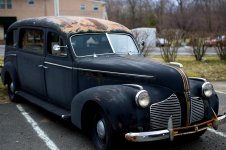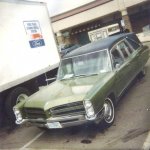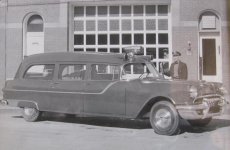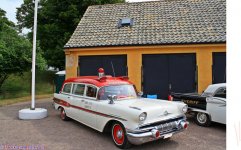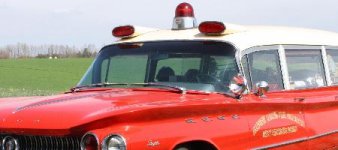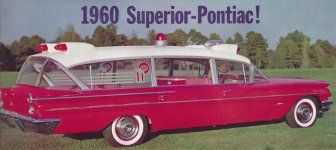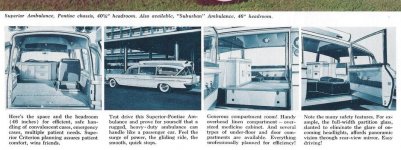I just also noticed the wheel covers and rear tire white wall is also not the same as the movie photo.
You are using an out of date browser. It may not display this or other websites correctly.
You should upgrade or use an alternative browser.
You should upgrade or use an alternative browser.
Pontiac procar pics
- Thread starter Steve Loftin
- Start date
Skip Goulet - Deceased 1945 - 2018
August 19, 1945 - July 26, 2018
It would be interesting to know if either of the 2 survived and if they are still here in Iowa. As a kid, I was just in awe of these 2 long wheel base Pontiacs as we just had a '62 Chevy wagon as an ambulance in Blue Earth, MN(no offense Paul!). That '62 Chevy wagon ended up in the local demolition derby in the late '70s.
The first-ever ambulance our small REACT group in Lubbock had was a '60 Chevy wagon that had belonged to the race track where we worked. We had mobilized with a borrowed Olds ambulance when the big tornado hit Lubbock in 1970, and because of the good publicity we got from it, the track gave us their old wagon. It lasted until late '71 when it was replaced with a '63 Consort.
Heres a '55 Pontiac I found back in late 2012 in a local yard to me. The paint scheme says "Echo Fields Raceway" in Cranbrook BC, Canada. (It was the track ambulance for a number of years.) Most of the interior was still inside as well.
The car was very straight with no collision damage and only a minor amount of rust. The Yard owner tried to keep the elements out by covering what broken windows the car had.
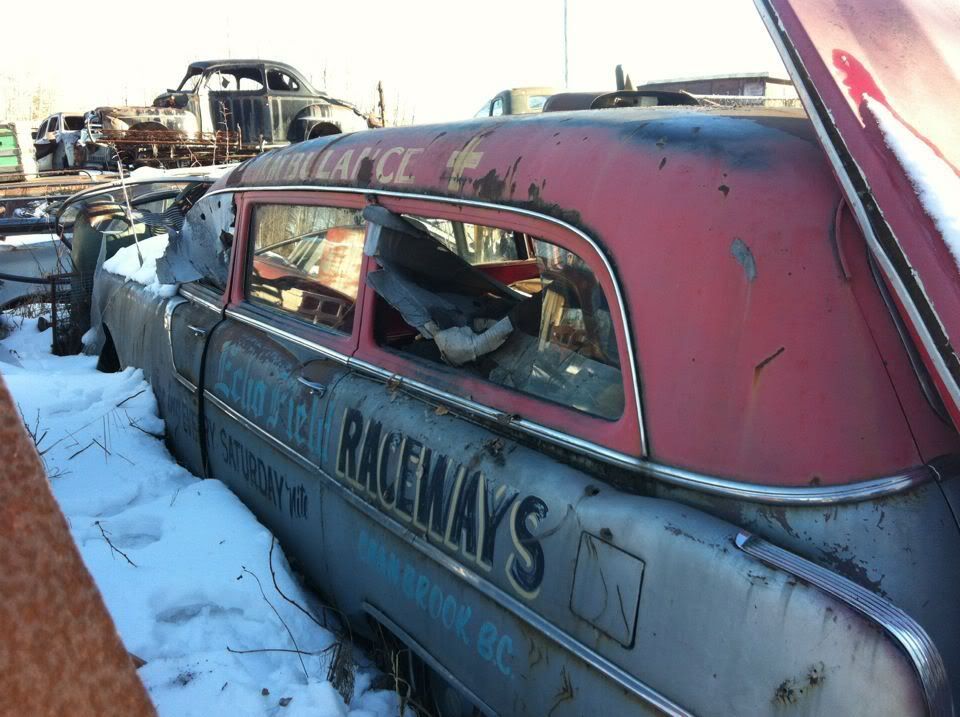
The car was very straight with no collision damage and only a minor amount of rust. The Yard owner tried to keep the elements out by covering what broken windows the car had.

Page 155 of the Superior book shows two shots of a well preserved '40 Superior Pontiac Oakridge funeral car. It traveled to PCS Pittsburg meet in '94 and was owned then by Jim Stio of Carlstadt, NJ.
Fast forward 19 years. Below capture was taken just this past week 30 miles away in Green Village, NJ and randomly posted on Flickr. My guess is that Mr. Stio passed and '40 has not been in family for some time.
Someone save this rare coach before it deteriorates further please.
Fast forward 19 years. Below capture was taken just this past week 30 miles away in Green Village, NJ and randomly posted on Flickr. My guess is that Mr. Stio passed and '40 has not been in family for some time.
Someone save this rare coach before it deteriorates further please.
Attachments
1966 Superior Pontiac hearse. My favorite non-Cadillac pro car.
The '66 S/Ps are among my favorites, as well.
But -
 - where is it from, and/or where did it serve?
- where is it from, and/or where did it serve?- where is it from, and/or where did it serve?
No idea, unfortunately. This photo is from an eBay auction that ended last week of a Polaroid photo with no additional information.
Rare '58 Memphian Pontiac combination has surfaced in OK. Side trim makes me think a Star Chief Custom Catalina sedan was used for conversion - and it looks even better with that subtle Memphan 'M' in place of Pontiac crest. Note this coach has corner windows. More images will post if forwarded.


Rare '58 Memphian Pontiac combination has surfaced in OK. Side trim makes me think a Star Chief Custom Catalina sedan was used for conversion - and it looks even better with that subtle Memphan 'M' in place of Pontiac crest. Note this coach has corner windows. More images will post if forwarded.
Nice find! I'll bet that one is this one:
http://www.professionalcarsociety.org/forums/showpost.php?p=30793&postcount=15
Skip Goulet - Deceased 1945 - 2018
August 19, 1945 - July 26, 2018
1966 Superior Pontiac hearse. My favorite non-Cadillac pro car.
Very nice photo, Adam. If it were a combination and I found it, I'd grab it in a hurry!
Skip Goulet - Deceased 1945 - 2018
August 19, 1945 - July 26, 2018
Nice find! I'll bet that one is this one:
http://www.professionalcarsociety.org/forums/showpost.php?p=30793&postcount=15
Would that one have been Gene Griffin's old car from Tulsa, Steve? Looks a lot like it. The last pic I saw of it, however, showed the car in much better shape.
Hadn't seen this restored Reese Air Force Base Lubbock, TX '57 Superior Pontiac yet, via Flickr posted by Trucks and nature. Wouldn't guess that a military rig had tunnel lights originally (plus they're mounted on a funky angle) and am curious what those came off.
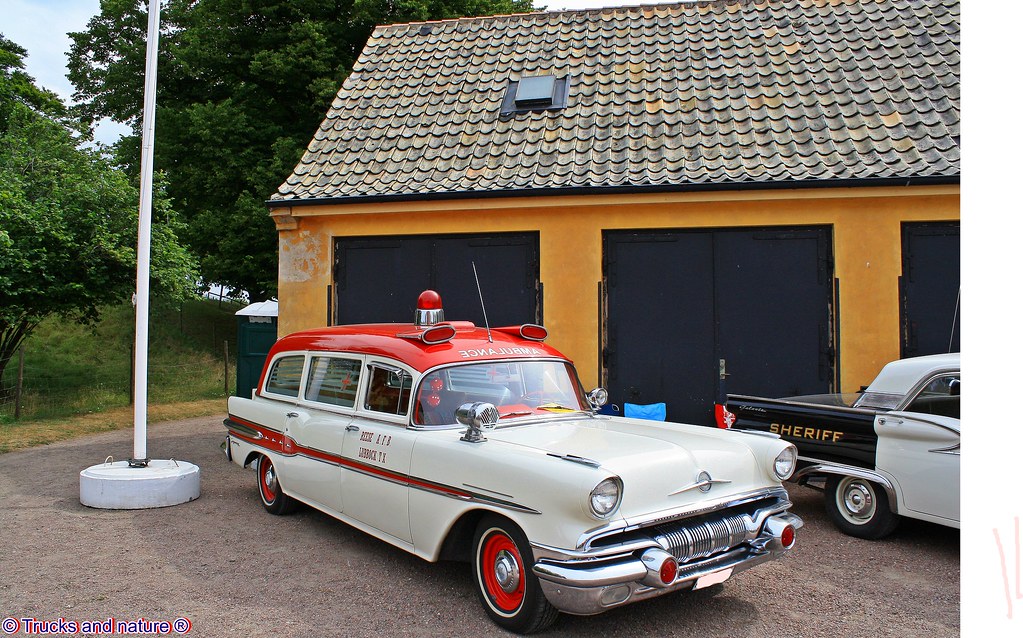
http://www.flickr.com/photos/29687978@N02/8565463507/

http://www.flickr.com/photos/29687978@N02/8565463507/
Attachments
Hadn't seen this restored Reese Air Force Base Lubbock, TX '57 Superior Pontiac yet, via Flickr posted by Trucks and nature. Wouldn't guess that a military rig had tunnel lights originally (plus they're mounted on a funky angle) and am curious what those came off.
Short version: This is one of three or four that were purchased in about 1970 by the City of Lubbock when the funeral homes were threatening to exit the ambulance business.
Keith Snyder
PCS Member
Would that one have been Gene Griffin's old car from Tulsa, Steve? Looks a lot like it. The last pic I saw of it, however, showed the car in much better shape.
Tom McPherson and Walt McCall visited Gene Griffith last week in Tulsa and had the opportunity to view his cars. Although they were jammed together in a large garage, he reports that the vehicles are impressive. Gene still has his tri-power 1958 Pontiac combination but, unlike the one pictured here, his is a Barnette and appeared to be in excellent condition.
Skip Goulet - Deceased 1945 - 2018
August 19, 1945 - July 26, 2018
Short version: This is one of three or four that were purchased in about 1970 by the City of Lubbock when the funeral homes were threatening to exit the ambulance business.
Thanks,Steve. The date was actually 1966. Lubbock bought about 8 of these old Pontiacs. They came with an "M" light on the roof and an EG behind the grille. To this they added a pair of Dietz lollipops, one on each side of the "M" light and a 66G on the rt fender, as in this picture.
In 1966 Rix, Sanders, Henderson and Franklin-Bartley all announced that they would discontinue their ambulance service. So they city came up with the above-mentioned ambulances. The idea was to put one at each of the fire stations and two at Central. The idea was fine, but it just didn't work out. The old Pontiacs were just that: old! With almost every run the responding ambulance would break down and another one would have to be called.
Then as if by a miracle (pun intended), Henderson announced that they would stay in the ambulance business. Their fleet in '66 consisted of a '61 C/B Seville ambulance (which I would buy from the small town of Sundown in 1973), a '64 Chevy wagon and a '66 Ford wagon, both which were built by the Gordon K. Allen Co.
With Henderson's announcement, the Lubbock Fire Dept immediately discontinued their ambulance operation, and Henderson was given the city contract. LFD kept two of the '57 Pontiacs just for "backup" purposes, but never used them in that capacity. One of them was sold at auction not long after my arrival in Lubbock in 1968. The other was kept at Central, and for many years was stationed at the Panhandle/South Plain Fairgrounds in Lubbock during the fair's run every September. In the mid-70s after Lubbock County EMS was established thru the Lubbock County Hospital District, EMS began to cover the fair and LFD sold the remaining Pontiac ambulance. I got beat out on it by just a small amount. It ended up on a local car lot where it remained for a number of years. The lot's owner had a ridiculously high price on it, and I never could deal with the guy. It sold sometime in the late '70s or early '80s and I never knew where it went.
As to Henderson, since they only had three ambulances to cover a city of then about 150,000, they bit of more than they could chew. Henderson was located two blocks east of the Texas Tech campus on Broadway, which was just west of Downtown Lubbock. It turned out that Henderson had a very hard time getting an ambulance out to the SW part of town which was experiencing a lot of growth. So a number of people petitioned Franklin-Bartley to re-enter the ambulance business. Bob Bartley reluctantly agreed and approached the city council. They were allowed to re-enter the ambulance service, but it would be totally without city dispatch-oriented calls. Simply put, they ran the calls they actually received; and that wasn't all that easy. A new rule was put in effect: they had to call the city dispatch center via telephone and request clearance to make an emergency run. On a lot of calls they were told, "Sorry, Henderson's already enroute" and then give the call to Henderson. That was in mid-1967. F-B had re-entered with a pair of nice Pontiac ambulances: a 1967 lwb Pontiac straight ambulance and a '64 Consort combo. They made their share of calls, but having to compete against the city and Henderson was just too much; so Bob Bartley got with the owners of Rix, Sanders and Resthaven (who never ran an ambulance service), and the outcome of that meeting was the formation of an "Ambulance Corporation" later known as AID Ambulance. And just like what F-B had gone through, AID did as well, having calls "stolen" by the city and given to Henderson. I dispatched part-time for AID from 1968 until 1972. In '72 Henderson literally "shot themselves in the foot".
Walter Henderson disliked black people and disliked even more having to transport them. But he had the city contract and had no choice. So all of a sudden we started receiving calls from the city dispatcher asking us to run on this or that, explaining that Henderson wasn't available. We gladly made the runs; but we began to see a pattern to it. All of the calls were in East Lubbock which was mostly black. So we started watching Henderson closely, and when we got a Henderson turn-down, our manager sent one of us to walk down the alley behind Henderson, as both businesses were only a block apart; and on 9 out of 10 calls, Henderson hadn't rolled an ambulance anywhere. We kept track all that and it was all documented. And one morning late in '72 a city sanitation worker was run over by his own truck. Henderson got the call which was in East Lubbock and immediately refused it. AID was called but had all 3 units that they had tied up. Finally AID got a unit loose and headed to the scene; and apparently someone at Henderson decided that it was in their best interest to respond. They beat AID to the scene by two blocks and transported, but the guy was DOA. Walter Henderson and AID Manager (now owner) David Ehler both had to appear before the city council to explain what had happened. David produced the documentation of all the Henderson turn-downs and that was it. Henderson surrendered his permit and AID became primary ambulance until the county formed Lubbock EMS in 1975. AID is still the primary non-emergency service. But what a rollercoaster ride!
Skip Goulet - Deceased 1945 - 2018
August 19, 1945 - July 26, 2018
Hadn't seen this restored Reese Air Force Base Lubbock, TX '57 Superior Pontiac yet, via Flickr posted by Trucks and nature. Wouldn't guess that a military rig had tunnel lights originally (plus they're mounted on a funky angle) and am curious what those came off.

http://www.flickr.com/photos/29687978@N02/8565463507/
Atty: did they say where those cars are now?
At the risk of a Pontiac thread being overtaken by a Buick, may I offer a suggestion of the origin of the unusual tunnel lights - '60 Flxible?...Wouldn't guess that a military rig had tunnel lights originally (plus they're mounted on a funky angle) and am curious what those came off.
The lenses are Olds taillights.
Attachments
Skip Goulet - Deceased 1945 - 2018
August 19, 1945 - July 26, 2018
Just a bit of an update from my previous post about the '57 Pontiac. That car never served Reese Air Force Base. In that time period they used a 1956 Chevrolet Sedan-delivery ambulance at Reese. From there they went to long wheelbased lowtop Pontiacs followed by Ford and Plymouth station wagons. Their last coach ambulance was a 1974 lwb C/B Olds military hightop ambulance.
The City of Lubbock bought their entire fleet of those '57 Pontiacs through the Texas Surplus Property Agency office in Lubbock. All of them were painted white at the time of purchase, not Air Force blue.
Steve Loftin: Do you still have the copy of the '57 Pontiac ambulance in its original state that was part of the "old Lubbock Fire Dept pix" that you sent me a couple of years ago.?
The City of Lubbock bought their entire fleet of those '57 Pontiacs through the Texas Surplus Property Agency office in Lubbock. All of them were painted white at the time of purchase, not Air Force blue.
Steve Loftin: Do you still have the copy of the '57 Pontiac ambulance in its original state that was part of the "old Lubbock Fire Dept pix" that you sent me a couple of years ago.?


